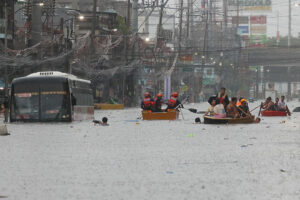By Arup Chatterjee
AN AVERAGE of 20 storms and typhoons hit the Philippines each year, leading to flooding, landslides, and storm surges that ravage communities and cause significant economic losses. No other country is more at risk from natural hazards, according to the World Risk Index.
Implementing proper financial protection arrangements is crucial to climate change resilience by better managing residual risks and setting incentives for financial preparedness. The Philippines has an enormous catastrophe protection gap — the difference between optimal and actual insurance coverage — at 98%, compared with the world average of 58%. The insurance penetration rate is currently less than 1%, leaving many people, especially in vulnerable communities, acutely exposed.
Climate risk manifests in two ways. First, physical risks can damage properties and disrupt supply chains, causing enormous economic losses. A lack of climate risk mitigation infrastructure and other capacities exacerbates this. Second, policy, technology, and market sentiment shifts raise costs, reduce incomes, and strand assets amid a transition to a low-carbon economy. Both types of risks impair asset values and the credit quality of loans and investments from banks, financial institutions, insurers, and capital markets.
ADB
Without appropriate countercyclical financing mechanisms, such as income-smoothening social safety nets and public insurance schemes it can create sizeable implicit contingent liabilities for the government in its disaster response due to a perceived moral obligation for it to pay for losses.
Yet, national and local governments across Asia and the Pacific have been slow in integrating climate risk into their decision-making and strategies.
As society’s risk managers, insurers play a critical role in the intricate web of climate change complexities, ensuring financial stability. The insurance industry’s unique expertise enables it to assess and price risk through differential premiums and set deductibles to incentivize climate-resilient and green investments.
IMPACT OF EXTREME WEATHERMoreover, price signaling can incentivize policyholders to mitigate risk and minimize the impacts of extreme weather.
For instance, the International Energy Agency forecasts that renewable energy sources such as solar and wind will contribute 49% of global electricity generation by 2050. By popularizing insurance that covers the entire life cycle of renewable energy projects, the Philippines can de-risk energy efficiency financing, providing confidence to potential private investors in green technology projects.
Earlier this year, a dangerous heat index of 43 degrees Celsius led to severe livelihood, food, and health insecurities. Innovative heat-stress insurance can reduce these impacts by offering financial compensation and shock-responsive social protection. For example, vulnerable women working in extreme heat can receive multiple payouts to compensate for missed work when temperatures hit a pre-determined level over a pre-defined period.
The International Rice Research Institute estimates that grain yield decreases by at least 10% for each 1-degree Celsius increase in growing-season minimum temperature in the dry season. In the agriculture sector, crop insurance is crucial in securing the livelihoods of Filipino farmers against multiple risks. By offering discounted premiums for climate-resilient measures like sowing drought-resistant seeds, these insurance schemes can significantly increase their overall cost-effectiveness in the face of climate-related risks.
It is important to keep in mind that while climate-related risks present challenges to insurance operations, they also present opportunities for growth and innovation. The insurance sector in the Philippines is currently facing these headwinds, but by focusing on strengthening risk-based and market conduct regulations, developing new taxonomies — a key strategy in addressing climate-related risks, and implementing best practices, the Philippines insurance sector can pave the way for new product development that meets the demands of a changing risk landscape.
These factors can affect the insurability of policyholders’ assets and incomes, and insurers’ operations and investments. Increased natural catastrophe exposure can lead to significantly greater risk capital requirements, reduced reinsurance capacity for nonlife insurers, or higher premiums.
Policyholders vulnerable to climate-related catastrophes may face financial exclusion as premiums become unaffordable or the cover is not within an insurer’s risk appetite. The delicate balance between premium affordability and risk-reduction incentives is critical in this scenario.
ROLE MODELThe insurance industry should prepare itself to play a pivotal role in reducing residual risks and narrowing the protection gap by actively pursuing financial risk literacy. This is not just a challenge but an opportunity for the industry to make a significant positive impact.
The Philippines is seen as a role model for implementing a toolkit of sovereign disaster risk financing instruments using a risk-layered approach. This involves using multiple financial instruments, each with a different risk profile, to manage and mitigate the impact of climate change-induced events. By diversifying the risk, the Philippines can reduce the overall financial implications of these events.
Public-private partnerships and pooling mechanisms can provide affordable coverage, helping real-economy actors to absorb shocks and protect their debt-service exposure against climate change-induced events. This underscores the importance of collaboration in addressing climate change risks. The Asian Development Bank (ADB)-supported Philippine City Disaster Insurance Pool project will provide cities with cost-effective insurance and offer near-immediate payouts for post-disaster response.
The Philippine insurance industry must invest in modern data management systems to reshape the insurance value chain. A much greater volume, velocity, and granularity of data is also needed to allow consumers and insurers to understand and price risks. Any successful response must involve compulsory and voluntary measures backed by a robust assessment, implementation, and monitoring framework that leverages the latest technologies — big data, data analytics, automation, artificial intelligence, and machine learning.
Finally, policy reforms are needed to drive climate-sensitive public policies and disaster risk management solutions. Environmental, social, and governance issues are gaining traction with institutional investors on projects that deliver measurable nonfinancial benefits while improving long-term financial returns.
Insurers must shift business models away from transactional risk transfers and indemnity payments toward mitigating physical climate risks. These can include rebates for using resilient construction materials, working with governments to improve land use planning and building standards and policies, and supporting a just transition to clean energy.
Climate action can improve lives, create jobs, build green cities, and protect ecosystems. The Philippine insurance industry is well-equipped to play a crucial role by reducing residual risks and narrowing the protection gap by actively pursuing financial risk literacy.
Arup Chatterjee is principal financial sector specialist of the Finance Sector Group of the Asian Development Bank.






